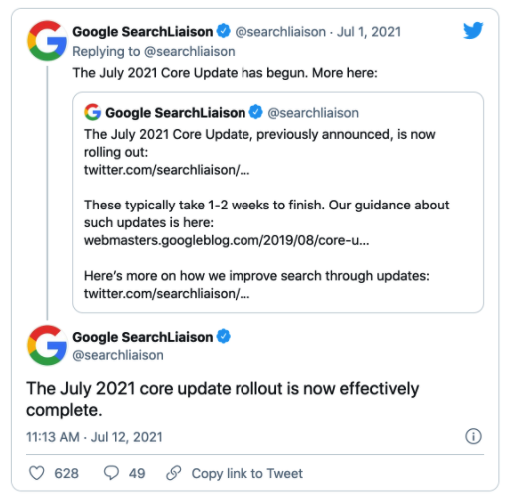If you were holding your breath during the Google Product Reviews update back in April 2021, well… don’t exhale just yet!
In 2021, Google decided to roll out one “broad core update” in two separate parts. The previous update was in June 2021, so it’s already had some time to impact rankings – but the second part just rolled out in July 2021 (effectively ending on July 12)
it’s possible that you’ll see even more change as a result of July’s update – or just as possible, you won’t notice any changes at all.
Here’s what to make of it all for your own site.
Table of Contents
ToggleA little bit of history: Back in early June 2021, Google announced its two-part update. Like with any core update, this one was all about changes to the core search algorithm, which covers every niche and type of content on the web. This is in comparison to more narrow algorithm updates like the product reviews update, which specifically targeted a subset of content with a handful of tweaks.
What’s interesting is, you may be sitting here having already seen drastic changes in June. Many site owners did. And now, it’s possible that you’ll see even more change as a result of July’s update – or just as possible, you won’t notice any changes at all.

Here’s what to make of it all for your own site.
All indications are that July was a big Google search update, along with the previous core update in June!
I’ve seen reported numbers that are all over the map. Some people saw no change, others saw organic traffic down a modest 15%, and still others saw a healthy uptick in traffic on their websites. Even tools like the SEMrush sensor saw greater volatility after this update rolled out!
Other site owners have noticed that their how-to articles have been pushed down in the SERPs by videos, or that larger ecommerce sites like Amazon or Home Depot are outranking their commercial posts now.
Unfortunately, there is no single story here with the core update – it’s never the same result for everyone, almost by definition!
Instead of worrying too much about the results of this two-part core update, it’s worth improving your site as a whole to make sure it can weather the storm of any forthcoming core updates from Google.
I own my own affiliate site too, and I see my rankings bounce around over the course of only a few weeks, so I understand the anxiety that can come with an update!
However, as far as Google is concerned, it always comes back to the same thing: creating a better experience for users. That’s the same thing Google wants to provide as well. In practice, a better user experience can include everything from quality relevant content to good site design to solid core web vitals.
But this vague idea of a “better user experience” isn’t particularly helpful for marketers and entrepreneurs in the real world, so here are 3 tips that will actually help you future-proof your site from Google core updates!
The longer I’ve been in the SEO game, the more I’ve come to see that there’s truly a formula for content that ranks at the top of Google or wins featured snippets. Virtually everything you need to know about is found right there on the SERP for whatever you want to rank for.
As an example, if you want to write about “mane thinning” for horses (and rank for that keyword), you can look at the search results and see a few things right off the bat:
Believe it or not, these results tell you a LOT about buyer intent and what Google thinks people want to find when searching for a term. I would say 90% of the time, there’s a dominant article type for a given search term – and you’d be wise to make sure yours is that type as well.
Commercial content like product reviews, product comparisons, and listicle buying guides. (ie money posts)
Informational content like how-to guides, question and answer posts, and list posts.
Ecommerce pages where a product is listed for sale.
In addition to article types, you may occasionally see multimedia results like videos, images, rich snippets like recipes, and more.
Luckily, when you know the type of blog posts to write, your articles will be evergreen in Google’s eyes and less likely to lose in core updates.
No matter how often it seems like Google is going to move away from backlinks as a ranking factor, it hasn’t really happened in more than 20 years. In reality, Google is always likely to use your backlink profile as one way to determine how trustworthy and useful your content is!
So, it’s still worthwhile to seek out quality links through all kinds of practices, with strategies like guest posting, press mentions, broken link building, podcasts, forums, social media, and more. Focus on links from sites with a higher domain rating than yours, and always try to earn contextual links (or links that point to deep pages on your site instead of just the home page).
With all that said, it’s worth being aware of Google’s new link spam update (which also started releasing in July 2021), The link spam update exists because Google wants to deter site owners from selling outbound links for money.
Bottom line: If you use spammy link building practices, it could hurt your site – so focus on quality white-hat link building.
The full impact of core web vitals on search ranking is still uncertain, but there’s no question that they play a big part, as they’re now an official ranking factor.
In fact, one of the most important aspects of the new core update was a greater emphasis on Core Web Vitals, which is a gauge of your website’s performance for a searcher who is landing on your page.
In layman’s terms, the phrase “core web vitals” is just a fancy way of saying “user experience update,” though there’s obviously more nuance to it than that.
Largest contentful paint – how long it takes for the first image or text to load.
Interactivity – how long it takes the browser to respond compared to when a user first interacts with the site.
Visual stability – To what extent your page content shifts around while the site is rendering.
These are all page experience signals, a factor that’s only becoming MORE important in determining what’s going to get more visibility and rankings in the SERPs.
By getting at least a “good” score for the Core Web Vitals, you’ll be able to protect your content site’s rankings in search.
I hope this quick look at the mid-2021 Google search core update was helpful for you!
Just remember, creating quality blog posts is only one (albeit important) piece of the puzzle. SEO involves a lot of moving parts, but still offers tremendous opportunity to grow and monetize your own website.
No matter where you’re at in your journey as a website owner, don’t forget that you can always buy or sell a site right here on Motion Invest! In the end, this core update is unlikely to change things very much, but it’s always important to tune into any SEO industry chatter so you can make the best decision for your business.
For more information on buying or selling a site with Motion Invest, please visit our buy site page here or our sell site page here. And don’t forget to check back on the Motion Invest blog for more industry news and updates!

Motion Invest has helped thousands of entrepreneurs just like you to sell and buy websites.
Please fill out the form below to submit an offer. Please note that for new sites we usually don’t look to offers for the first 48 hours.
Please fill out the form below to submit an offer. Please note that for new sites we usually don’t look to offers for the first 48 hours.
Please submit an offer below. Please note that offers usually take 48 hours to sort through.